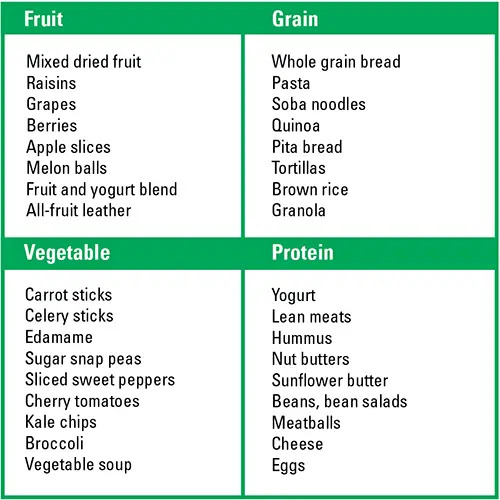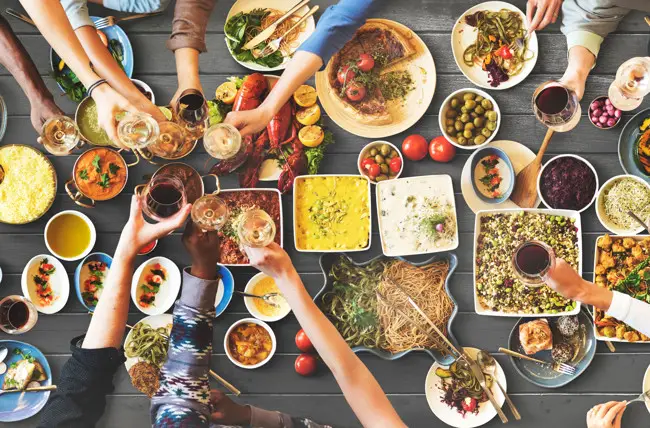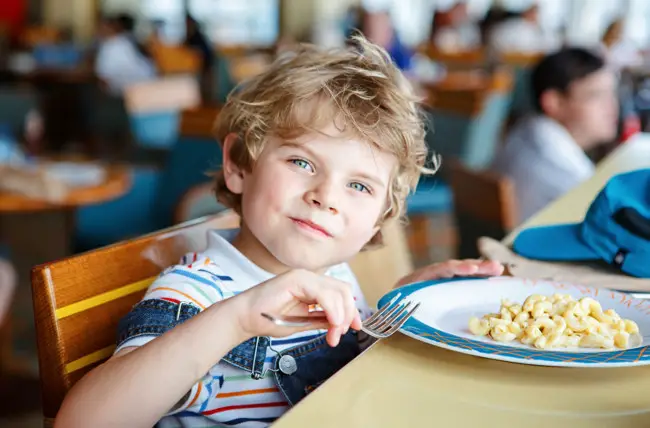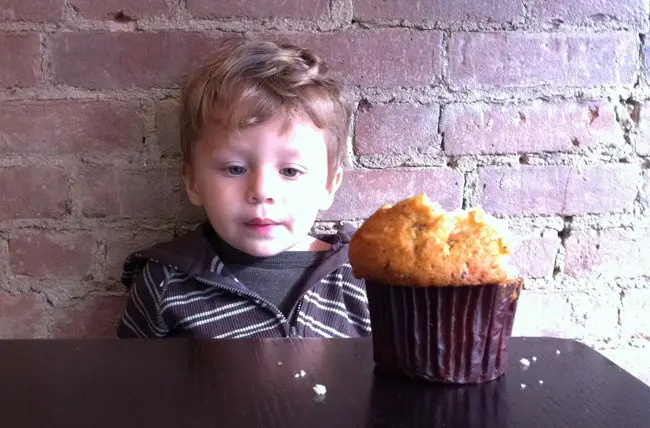Some children forgo eating at lunchtime to be social. Here’s how to get your kids to eat a healthy lunch while chatting with their friends.
Chances are it’s been a while since you’ve ordered “hot lunch” in the school cafeteria. Whether you send a home-packed lunch with your child or they order lunch, eating in the cafeteria can be overwhelming at first. Coach Mel [Melanie Potock, M.A., CCC-SLP ] had a client who called it the “café-FEAR-ia” because the whole experience was a bit scary for him.
Imagine being a brand-new kindergartner, toting your sparkly new Disney princess lunch box down the school hallway, when you turn and enter utter chaos. Older kids tower over you as you cross the sea of tables and try to find where you are supposed to sit for the next 20 minutes. Irritating fluorescent lights flicker while children chatter, teachers clap loudly to insist on silence, and rebellious kids ignore the adult plea and pop potato chip bags open with a bang! Metal lunch boxes clang as hungry tykes unpack a multitude of tins, cartons, juice boxes, and squeezable thingamajigs. The display on the tables is like a giant fire sale.
Now picture the typical metal cafeteria table with benches made to fit the average fifth-grader. Your kindergartner’s feet are dangling and there’s no backrest. She has to balance while her elbows hunch up practically to shoulder level in order to stabilize herself on the table edge, her little eyes barely able to see past the barrage of sandwich bags and containers spread before her. In an effort to ensure that their kids eat anything at all, well-meaning parents pack lunch boxes filled to the brim, typically with seven to eight different options.
She sits and tries to ignore the boy next to her who keeps elbowing her in the ribs as he turns to talk to his friend on the other side of her—and turns back to eat—and then turns back to his friend. By the time she gets out all the containers you’ve packed, plus the juice box straw finally unwrapped and poked hard enough that juice squirts her in the face, five minutes have gone by. She’s holding up her other hand to signal the teacher, “Can you please open this lid?” but there are three other kids who need help first. Meanwhile, that nice girl who played with her at the craft table this morning wants to chat—and she just wants to make friends.
Maybe she’ll get a few containers open and swig down that juice, but now her mind is on recess. Here’s the biggest dilemma: For most kids, their priority during that very quick lunch is to visit with their friends and get a few bites of food in in the process. However, teachers and the parents have a different priority for lunchtime: They want kids to have a nutritious meal so they are well fueled and ready to learn in the afternoon.
RELATED: Find a nutritionist near you
Solutions to the Cafeteria Chaos
If your school cafeteria resembles the picture we’ve painted above, and you want to rest assured that your child gets a healthy lunch in her belly, here are six solutions to finding some calm in the chaos:
Send one easy-open container plus a drink.
Bento boxes are all the rage nowadays. For many families, there is just enough time to get lunches packed and to grab them on the way out the door in the morning. The solution is a one-piece bento with an easy-open lid. Bentos are not as overwhelming as a lunch box filled to the brim with individual plastic bags, containers, and drippy fruit cups with tricky foil lids. Our favorites are EasyLunchboxes (the best-selling lunch-box system on Amazon) and the Yumbox (yumboxlunch.com). Both offer easy-open lids and compartments that are just the right size for kids. The Yumbox can be ordered with different trays that fit inside the box itself. Our favorite tray has five compartments each marked with a food group: Protein, Vegetables, Fruit, Dairy, and Grains to ensure a balanced lunch every time you pack.
Pack “grab and gab” food.
Cut fresh fruit, veggies, sandwiches, cheese, etc., small enough so that kids can grab a piece without having to look down, and continue to gab with their friends across the table. Using a cookie cutter to create food in a fun shape like a dinosaur keeps the eating on track for some kids. But for kids who tend to eat a sandwich and skip the other items, try cutting the sandwich into small pieces so the child alternates grabbing a variety of foods, much like a mini-smorgasbord. Remember, you don’t need to send a whole sandwich when sending half leaves room in little bellies for other key food groups.
|
Food companies have seemingly made things easy for us by creating premade lunches, with compartments filled with a complete meal including a dessert and drink. Your kids may ask for these because, of course, many of the packages are adorned with colorful graphics and familiar characters. Flip the package over and you may be shocked to find a laundry list of artificial preservatives and food dyes. One of the popular brands of packaged lunches also has as much as sixteen teaspoons of added sugar, which is almost three times what a young child should consume in a day. |
Include a power-packed smoothie that you made the night before.
Freeze it directly in a cup or Mason jar with a lid and be sure to include a wide straw. Wrap some rubber bands around the jar for added grip and to keep little hands from getting too chilly. By the time your child opens her lunch, the smoothie will be the perfect consistency, plus it helps to keep the lunch cold.
Pack last night’s dinner for lunch.
If your child has a favorite healthy dinner, find ways to pack it in his lunch the next day. Use insulated containers to keep soups, stews, or pasta warm for lunchtime. Using leftovers can save time packing lunch in the morning, too.
RELATED: Browse our favorite kid-friendly recipes
Pack a waste-free lunch.
A lunch-box system means that you won’t be throwing away plastic bags every day. Use brightly colored cloth napkins and stainless steel water bottles to make lunch even more fun. Use lunch packing as a chance to show kids that they help to reduce, reuse, and recycle.
Start weekly lunch-box dinners at home.
For kids transitioning to school lunch, introduce once-a-week lunch-box dinners where the entire family pretends to eat in the school cafeteria. At the entrance to the kitchen or dining area, one parent stashes a large bin, just like the kids will find at school. Each member of the family has their own distinct lunch box thrown into the bin, along with a few “old” random empty lunch boxes, so kids can practice digging down to the bottom to find their own. Once everyone is seated at the table, the child can practice the fine motor skills of unzipping zippers, unfastening Velcro flaps, and opening up containers. Choose a lunch box that is easy to open and pack it with “grab and gab” food, just like you would in the cafeteria. Once the meal is over, everyone latches their lunch box and puts it back in the bin, just like at school.
|
As a speech-language pathologist, I teach the parents engaged in lunch-box dinners with their child to practice this little script: “I’ve got ____ in my lunch!” In all my years of sitting in school cafeterias and listening to young kids, it’s always the first thing they say to each other. It’s their traditional conversation starter, usually accompanied by them proudly holding up the celebrity food—the star of the lunch box. I can attest that I hear just as many kids enthusiastically say, “I have fruit today!” as “I have chips today!” Try for the veggies. It’s really OK—it’s just as cool to have vegetables cut up into stars or other fun shapes so they can announce, “I have CUCUMBER STARS today!” Better yet, get the kids involved packing the lunches and creating fun shapes so they can exclaim, “I made carrot triangles for lunch!” |
Phasing in New Foods
When packing lunch, parents pray that their child will “just eat something!” But at the end of the day, especially if the child is a picky eater, parents sigh as they open the lunch-box latch and see that lunch has barely been touched. What can a parent do at home to encourage kids to eat lunch, even when they eat only five to 15 different foods and are hesitant to try anything new?
Here are some tips to encourage young eaters to explore beyond their preferred foods:
Begin with exposure.
Kids may need to see a new food multiple times before they may even consider trying it. That means they need to see it at school, too. If you’re thinking, “But he won’t eat it, so why pack it?” remember that the first step is helping your hesitant eater get used to the presence of that food in his lunch box again and again. Food doesn’t have to be eaten to serve a purpose in food education, and it doesn’t have to be a large quantity of food when first introduced.
Give kids ownership in the lunch-packing process.
All kids like predictability and being a part of the process. Ask them to help with choosing, preparing, and packing lunch items. They are more likely to enjoy food when they are involved.
Include a favorite, but just enough.
Most of us eat our favorite foods first, so be sure to include your child’s preferred food, but not too much. Provide just enough so that you won’t be worried that they are starving, but not so much that the other less-preferred choices don’t stand a chance.
No comments, please!
When the lunch box comes home, resist the urge to unpack it immediately. Give everyone a chance to breathe, especially those kids with sensory challenges who have difficulty with transitions from one environment to another. When you eventually open it, don’t comment about the contents. Say nothing, positive or negative. For many kids, it creates too much focus on whether they ate or not. For now, just wash it out and set it on the counter for your child to pack again later that evening. If your child mentions the food or requests it again, that’s the time to respond with a positive comment. Be careful not to say things like, “See, I knew you would like it!” You may mean well, but a child will typically interpret that as “See, I was right and you weren’t.” Try stating something positive, such as, “Pomegranates are one of my favorites—I like how they crunch and squirt at the same time in my mouth!”
Make a lunch-packing roadmap.
Skip the filler foods such as pretzels and chips and pack a balanced lunch by including items from all five food groups: proteins, grains, dairy, fruits, and vegetables. Use the chart below to keep you on track and have plenty of options that are frozen or shelf-stable in case you run out of fresh. A handful of frozen edamame or dried fruit can be a great stand-in for fresh vegetables or fruit in a pinch. Whether you have a selective eater or a “foodie” with a palate that rivals a Top Chef, have all the kids in your family create a packing map and be responsible for their own lunch packing. Kids can choose foods from each group while the parent provides the healthy food options and keeps the kitchen stocked! Remember, it starts with exposure and builds from there.

|
Kids need calcium for growing bones. Dairy foods like milk, cheese, and yogurt are a good source of calcium, but they are not the only way to keep bones healthy and strong. Nuts, beans, seeds, and leafy green veggies are also good sources of calcium that can also be packed into lunch. Hummus, which is made of chickpeas and tahini (sesame seed paste), is high in calcium and is a great lunch staple. Try a hummus wrap or cut veggies that your child can dip in hummus. |
Excerpt from Raising a Healthy, Happy Eater: A Stage-by-Stage Guide to Setting Your Child on the Path to Adventurous Eating, copyright © Nimali Fernando and Melanie Potock 2015. Reprinted by permission of the publisher, The Experiment. Available wherever books are sold. theexperimentpublishing.com
RELATED: Get family activities sent to you
























